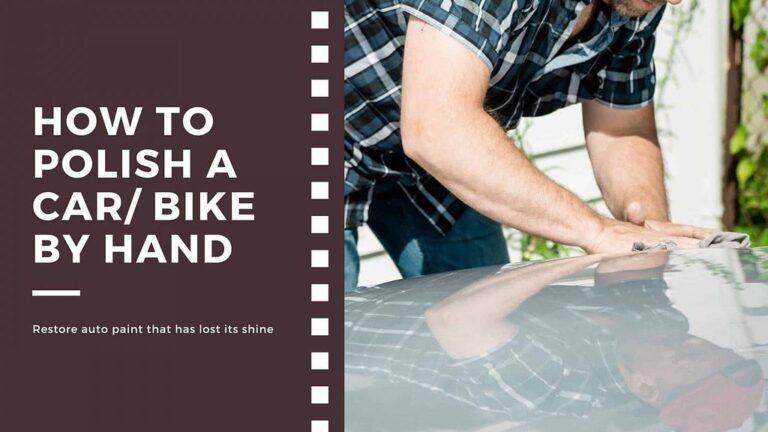Request a Call Back
What Is The Difference Between Hand Polishing and Machine Polishing How To Polish Your CAR Bike BY HAND!
Hand polishing and machine polishing are two different methods used to enhance the appearance of surfaces, such as automotive paint, furniture, or metal finishes. Here are the main differences between the two:

- Technique: Hand polishing involves using manual labor and physical force to apply polishing compounds or products onto the surface. It requires the use of hand tools like polishing pads, cloths, or applicators. Machine polishing, on the other hand, utilizes power tools, such as rotary or dual-action polishers, which mechanically rotate or oscillate to apply the polishing compounds.
Also Read – Paint Protection Film
- Efficiency and Speed: Machine polishing is generally faster and more efficient than hand polishing.
- The mechanical action of the machine polisher allows for greater coverage and quicker application of the polishing compounds, resulting in faster results. Hand polishing requires more time and effort to achieve the same level of correction or enhancement.
- Consistency: Machine polishing can provide more consistent results compared to hand polishing. The movements of machine polishers are usually uniform, ensuring even distribution of the polishing compounds and consistent pressure on the surface. Hand polishing may vary in pressure, motion, or product application, leading to potential variations in the final outcome
- .
- Correction Abilities: Machine polishing often has greater correction abilities than hand polishing. Machine polishers, especially rotary polishers, can generate higher levels of abrasion and cutting power, making them more suitable for removing deeper scratches, swirl marks, or oxidation from the surface. Hand polishing is generally better suited for lighter correction or final finishing stages.
- Skill and Learning Curve: Hand polishing requires less specialized knowledge and technique compared to machine polishing. It is relatively easier to learn and master basic hand polishing techniques. Machine polishing, on the other hand, requires more skill, experience, and practice to ensure proper tool control, pressure, and speed. Improper machine polishing techniques can potentially damage the surface.
- Cost: Hand polishing is typically more affordable since it requires fewer tools and equipment. Machine polishing may involve the purchase or rental of power tools, different types of polishing pads, and other accessories, making it a more significant investment.
What are the Benefits of Car Polish
Car polish offers several benefits for the appearance and protection of a vehicle’s paintwork. Here are some of the key benefits of using car polish:
Also Read – Ceramic coating for bikes
- Enhanced Gloss and Shine: Car polish helps restore and enhance the gloss and shine of the vehicle’s paint. It removes oxidation, light scratches, swirl marks, and other surface imperfections that can dull the paint’s appearance. By smoothing out the paint surface, polish can bring back a deep, reflective shine
- .
- Paint Correction: Car polish is designed to correct minor paint defects, such as swirl marks, light scratches, water spots, and oxidation. The abrasive particles in the polish gently remove a thin layer of the clear coat, leveling the surface and improving its overall appearance. This process can restore the paint’s smoothness and clarity
- .
- Protection against UV Damage: Car polish often contains protective additives that help shield the paint from harmful ultraviolet (UV) rays. UV radiation can cause fading, discoloration, and deterioration of the paint over time. By applying a car polish with UV protection, you can extend the life of your vehicle’s paint and maintain its vibrant color.
- Increased Hydrophobic Properties: Some car polishes have hydrophobic properties, meaning they repel water and create a self-cleaning effect. These polishes help water and dirt slide off the paint surface more easily, reducing the adhesion of contaminants and making the car easier to clean. This can also enhance the overall appearance by keeping the paint cleaner and reducing the frequency of washing.
- Smoother Surface: Car polish can make the paint surface smoother by removing imperfections and filling in minor scratches or swirl marks. A smoother surface not only looks better but also reduces drag, leading to improved aerodynamics and potentially better fuel efficiency.
- Preparing the Surface for Wax or Sealant: Car polish is often used as a preparation step before applying wax or paint sealant. By polishing the paint, you create a clean and smooth surface that allows the wax or sealant to adhere better and provide longer-lasting protection.
- Preservation of Resale Value: Regularly polishing your car can help preserve its resale value. Maintaining a well-maintained and glossy exterior can make the vehicle more attractive to potential buyers, and it indicates that the owner has taken proper care of the vehicle over time.
Machine Polishing vs Hand Polishing
Machine polishing and hand polishing are two distinct methods used to enhance the appearance of surfaces, particularly automotive paint. Here’s a comparison between the two:
Machine Polishing:
Efficiency and Speed: Machine polishing is generally faster and more efficient than hand polishing. The power tools used in machine polishing, such as rotary or dual-action polishers, allow for quicker application of polishing compounds and larger coverage areas. This makes machine polishing well-suited for larger surface areas or more extensive correction work.
Consistency: Machine polishers provide more consistent results compared to hand polishing. The movements of machine polishers are typically uniform, ensuring even distribution of the polishing compounds and consistent pressure on the surface. This helps to achieve a more uniform finish across the entire surface.
Correction Abilities: Machine polishing has greater correction abilities than hand polishing. The mechanical action of machine polishers generates more cutting power, making them effective in removing deeper scratches, swirl marks, and other surface imperfections. The level of correction achieved with machine polishing is often higher than what can be achieved by hand.
Learning Curve: Machine polishing has a steeper learning curve compared to hand polishing. Proper technique, tool control, and pad selection are crucial to avoid damaging the surface. It requires practice, experience, and familiarity with different polishing compounds, pads, and machine settings to achieve optimal results.
Risk of Damage: Improper use of machine polishers can potentially damage the surface if not used correctly. The high-speed rotation or oscillation of the machine, combined with excessive pressure or extended dwell time, can lead to paint burn-through or holograms if caution is not exercised.
Hand Polishing:
Precision and Control: Hand polishing allows for more precise control over the polishing process. With hand tools like polishing pads or cloths, you have direct tactile feedback and can apply pressure more precisely in specific areas that require attention. This makes hand polishing suitable for smaller, intricate areas or for spot correction work.
Safety and Ease of Use: Hand polishing carries a lower risk of damaging the surface compared to machine polishing. The manual application reduces the chances of excessive pressure or improper technique that may harm the paint. Hand polishing is generally considered safer and more forgiving, especially for beginners.
Accessibility: Hand polishing is more accessible since it requires minimal equipment and is less expensive than machine polishing. It can be performed without the need for power tools, making it a more convenient option for casual users or those without access to machine polishers.
Finishing Touches: Hand polishing is commonly used for final finishing touches after machine polishing. It allows for finer control over achieving a high-gloss finish, removing any remaining haze or micro-scratches, and enhancing the overall clarity and depth of the paint.
Which is The Best Car Polish Available in India for Hand Polishing
- 3M Perfect-It Rubbing Compound: 3M is another trusted brand in the automotive care industry. Their Perfect-It Rubbing Compound is designed to remove scratches and oxidation from the paint surface. It leaves a smooth finish and prepares the surface for waxing.
- Formula 1 Scratch Out: Formula 1 Scratch Out is a popular car polish in India known for its effectiveness in removing light scratches, swirl marks, and blemishes. It contains micro polishing agents that help restore the shine of the paint.
- Autoglym Super Resin Polish: Autoglym Super Resin Polish is a versatile product that can be used by hand or with a machine. It effectively removes light scratches, swirl marks, and oxidation, leaving a glossy finish. It also contains conditioning oils to nourish the paintwork.
